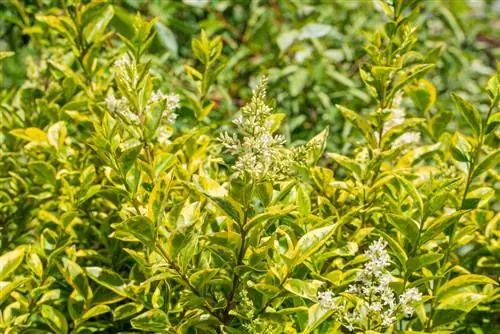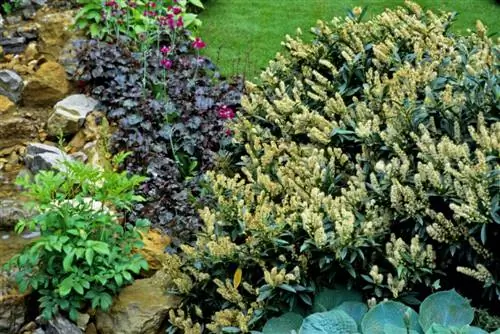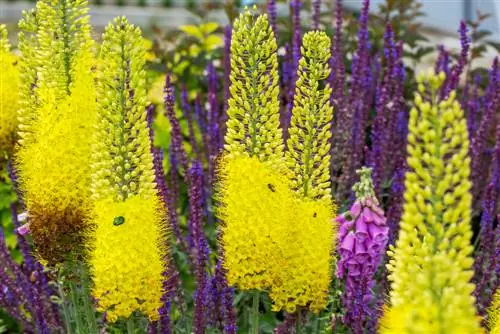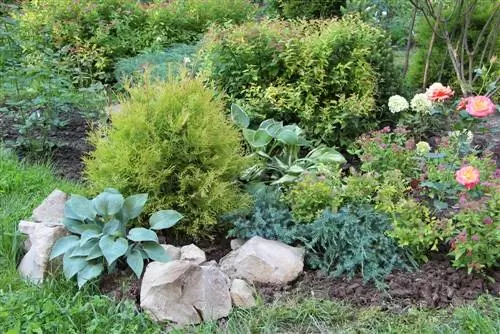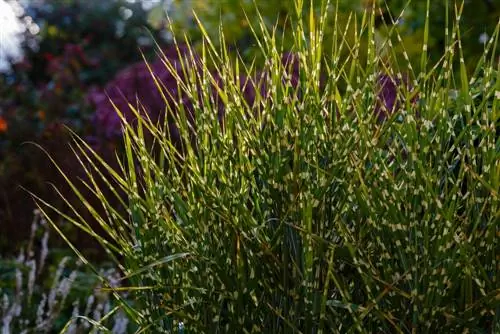- Author admin [email protected].
- Public 2023-12-16 16:46.
- Last modified 2025-01-23 11:22.
The gold privet is pretty to look at even as a solitaire. But it can only exploit its full potential when it can interact with other plants. With their mere presence, they have the ability to really bring the gold privet to life.

Which plants can be combined with golden privet?
Companion plants for golden privet should have similar location requirements and foliage colors. Roses, blue fescue, miscanthus, sun's eye, girl's eye and ranunculus bush all work well in the bed. Hornbeam, medlar, cherry laurel, barberry, firethorn, weigela and bladderwort are suitable for hedges.
What factors should you consider when combining gold privet?
In order to be able to enjoy the combination of the golden privet with companion plants in the long term, the following factors should definitely be taken into account:
- Foliage color: light green and golden yellow
- Flower color: white
- Flowering time: June to July
- Location requirements: sunny to partially shaded, permeable and nutrient-rich soil
- Growth height: up to 3 m
The two-colored foliage of the golden privet does not match all other plants. Combine it with similarly colored plants or create targeted contrasts to the green-yellow.
Not all visually suitable plant partners are suitable for the golden privet. You should also be able to cope with a sunny location and prefer nutrient-rich soil.
Essentially, the height of the golden privet is also important if you are looking for plants that harmonize with it.
Combine golden privet in the bed or in the bucket
In beds, the golden privet can become a valuable background plant or even a solitary centerpiece. It comes into its own most impressively when combined with perennials and grasses that, like it, have a yellow-green color. On top of that, it looks fantastic in a team with blue grasses such as blue fescue.
The best companion plants for the golden privet in the bed and in the pot include:
- Roses
- Blue Fescue
- miscanthus
- Suneye
- Girl's Eye
- Ranunculus
Combine golden privet with ranunculus bush
The golden privet and the tendril bush are a true dream pair. They form a wonderful symphony of color. The yellow flowers of the ranunculus complete the picture of the golden privet and when the tendril bush takes a break from blooming in midsummer, the golden privet reveals its white flower spikes.
Combine golden privet with blue fescue
Blue and yellow shine brightly in this combination. The blue fescue should be planted in front of the golden privet as it only stays close to the ground. With its blue stalks it accentuates the green-yellow foliage of the golden privet. This combination works best in the pot when the golden privet grows on a trunk and is planted under the blue fescue.
Combine gold privet with suneye
The sun's eye also goes fabulously with the gold privet. It also likes to stand in the sun and in summer the yellow of its flowers harmonizes with the yellow of the golden privet. To make the overall picture look relaxed, it is recommended to place several sun eyes in the foreground of the golden privet.
Combine golden privet as a hedge
The attractive appearance of the golden privet also comes into its own in a hedge. Combinations with trees with different colored leaves have proven successful there. It also makes sense to interact with evergreen hedge plants such as cherry laurel or firethorn, as golden privet also presents its foliage all year round. The following companion plants have proven to be successful for the hedge:
- hornbeam
- Cotoneaster
- Cherry Laurel
- Barberry
- Firethorn
- Weigela
- Bubble Spiere

